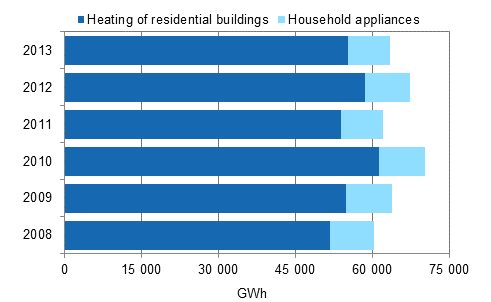Published: 14 November 2014
Energy consumption in households fell in 2013
Energy consumption in households went down by six per cent in 2013. Energy consumption in households, that is, heating of residential buildings and household appliances amounted to 63,427 gigawatt hours (GWh). As a result of the warm weather, the consumption of heating energy in residential buildings fell by six per cent. The energy consumption of household appliances went down by five per cent. For example, the lower use of car interior heating decreased consumption. The data are based on Statistics Finland's statistics on energy consumption in households.
Energy consumption in households

In 2013, electricity used on housing amounted to 21,510 gigawatt hours (GWh). Total electricity consumption fell by four per cent from the previous year, its share being 34 per cent of energy consumption in households. Electricity was consumed on both heating of interiors and household appliances. District heat was the next most used for housing, 29 per cent, and wood, 23 per cent. The consumption of district heat and wood is directed to heating of interiors. Housing accounted, on average, for 20 per cent of final energy consumption.
Heating of residential buildings consumed 55,140 gigawatt hours (GWh) of energy in 2013. The most common energy source of heating was district heat, of which 18,311 GWh was consumed. The next most consumed sources were wood, 14,502 GWh, and electricity, 13,233 GWh. These three largest energy sources accounted for 84 per cent of the consumption of heating energy in residential buildings. Heating energy of residential buildings comprises the energy of the main heating system and those of other forms of supplementary heating.
The use of heat pumps for heating of residential buildings has been growing in recent years. In 2013, ambient energy had a share of eight per cent in heating energy sources. Ambient energy refers to energy extracted with heat pumps from the environment used for heating of interiors. In these statistics the use of heat pump electricity is not included in ambient energy but in electricity consumption of heating. The cooling use of air heating pumps is not included in heating energy.
Outdoor temperature has an effect on the annual need for heating energy. Heating degree day is used to follow changes in that. According to the Finnish Meteorological Institute, the temperature in the summer months of 2013 was higher than usual in the whole country. December 2013 was also milder than normal. The exceptionally warm weather lowered the figures for heating degree days and thus the need for heating energy.
The energy consumption of household appliances, that is, cooking, lighting and other electrical equipment, was 8,287 GWh in 2013. Three per cent less energy was used on cooking and ten per cent less on lighting than in the year before. The fall in the consumption of cooking is explained by the decrease in the amount of food prepared from scratch at home. In turn, the switch to energy-efficient lamps has decreased the electricity need of lighting in recent years.
The consumption of other electrical equipment went down by four per cent. Other electrical equipment includes refrigeration equipment, washing machines, tumble dryers, televisions and computers with their accessories, lifts, and car interior heating. Similarly as the heating energy of residential buildings, the energy consumption of car interior heating went down due to the warmer weather than normal. The decrease in consumption is also influenced by the lower consumption during use and standby use of televisions.
With respect to the consumption of heating energy in residential buildings, the statistics on energy consumption in households are based on Statistics Finland's calculation model where various sources were utilised. The energy consumption data of household appliances are based on the calculations of Adato Energia Oy.
A new climatic reference period for heating degree days, 1981 to 2010, has been taken into use in calculating consumption of heating energy. The data have been updated in line with the new reference period starting from 2008.
Source: Energy consumption in households 2013, Statistics Finland
Inquiries: Jonna Hakala 029 551 3419, energia@stat.fi
Director in charge: Leena Storgårds
Publication in pdf-format (255.5 kB)
- Tables
-
Tables in databases
Pick the data you need into tables, view the data as graphs, or download the data for your use.
Appendix tables
- Figures
Updated 14.11.2014
Official Statistics of Finland (OSF):
Energy consumption in households [e-publication].
ISSN=2323-329X. 2013. Helsinki: Statistics Finland [referred: 19.4.2025].
Access method: http://stat.fi/til/asen/2013/asen_2013_2014-11-14_tie_001_en.html

